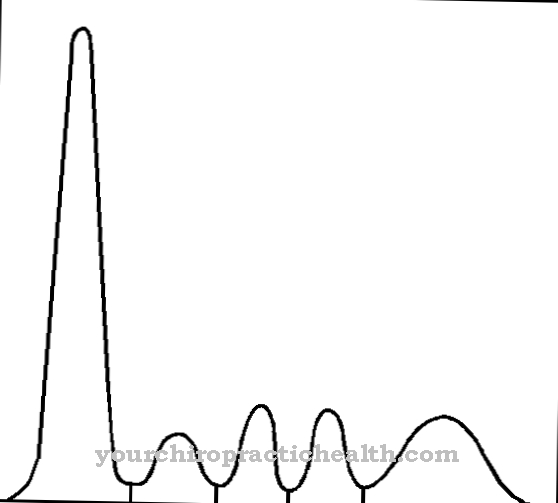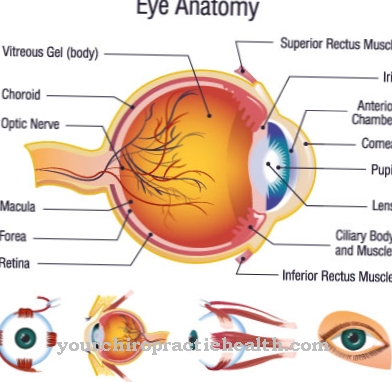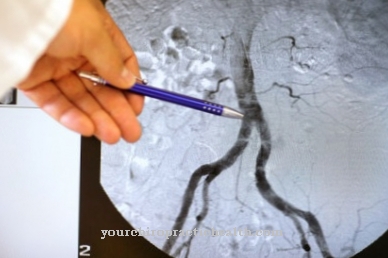At a Curvature of the septum (Septum deviation) deviates the nasal septum (septum) from the normal straight and central position and runs obliquely or is curved. Very often septal deviation is congenital, but it can also be acquired through an injury such as a blow to the nose.
What is a curved nasal septum?

© Henrie - stock.adobe.com
The Curvature of the septum is a deviation of the nasal septum (septum) and is referred to in medical terms as septal deviation.
The nasal septum consists of both cartilage and bone. It usually runs down the middle of the nose and divides it into two nasal cavities. However, since the human body is never completely symmetrical and designed as in the textbook, it is completely natural and very common for the nasal septum to be slightly curved. This is the case for around 80% of people.
As long as you are not restricted in your breathing, this small deviation can be considered normal. One speaks of a pathological curvature of the nasal septum if it causes breathing difficulties or frequent inflammations, which may not only infect the nose but also the sinuses and the throat and lead to chronic complaints.
causes
The Curvature of the septum is either congenital or acquired. The congenital form is hereditary. The acquired curvature of the nasal septum can result from forceful impact on the nose. It can happen that after a blow to the nose, for example from a fall or while exercising, the bone breaks and does not grow back together evenly afterwards.
In children who are still growing, it can happen that the bony and cartilaginous parts of the nasal septum grow at different speeds, which leads to a curvature of the nasal septum. Even if the midfacial bone does not grow smoothly, it can become curved.
Symptoms, ailments & signs
The central characteristic of a curvature of the nasal septum wall is an impairment of normal breathing. Mucous noses quickly lead to a complete closure of the airways. Not only the crooked nasal septum is responsible for the symptoms. The unfamiliar flow of air through the nasal canals also contributes to the symptoms.
Complaints about a blocked nose are more common, even though it appears completely free on examination. In many cases, those affected do not experience any pain or other symptoms. A subsequent shift due to an accident or swelling of the mucous membranes then quickly leads to problems.
Severe colds, but also an allergic runny nose, then block the passage for breathing air. The permanent shrinking of the airways leads to an accelerated air flow. As a result, the mucous membranes dry out quickly and are more prone to nosebleeds. If the curvature of the nasal sheath affects the air circulation in the paranasal sinuses, recurrent inflammation can be observed in these areas.
Bacterial infections even threaten to become permanent under these conditions. If the curved septum is in direct contact with the turbinate, it increases the tendency for spontaneous headaches. An abundant flow of secretions, however, is not one of the typical signs.
The inclination of the nasal septum occasionally reduces the sense of smell. The smaller nostrils disturb those affected in their sleep. Pronounced snoring and audible nasal whistling reduce the quality of sleep massively. As a result, patients suffer from a reduced ability to concentrate on the following day.
Diagnosis & course
A lighter one Curvature of the septum usually does not cause any discomfort. In the more severe form, breathing through the nose is often more difficult because the airflow is obstructed by the oblique shape of the septum. Those affected therefore breathe more often through the mouth, which can lead to more frequent inflammations in the throat (pharyngitis) and to snoring.
The nose is no longer adequately ventilated and germs settle in the nasal cavities. This leads to a runny nose and swelling of the nasal mucous membranes. As the disease progresses, inflammations develop that spread to the sinuses (sinusitis). Since the nose normally filters the air we breathe and frees it from germs, when we breathe through the mouth alone, the germs can migrate via the windpipe to the lungs and cause acute bronchitis there.
The doctor can examine the inside of the nasal cavity with a rhinoscopy and determine whether there is a curvature of the nasal septum. To do this, a nasal endoscope (tiny camera) is inserted after surface anesthesia (numbing) of the nasal mucosa. This enables the doctor to see the exact location, the nature and the course of the nasal septum and to make a reliable diagnosis.
Complications
If left untreated, a crooked nasal septum can result in complications that reduce the quality of life of those affected. Complications can also occur during treatment, for example in the form of a nasal septum surgery (septoplasty). Since a crooked nasal septum makes it difficult to breathe through the nose, those affected unconsciously breathe through their mouths.
Such breathing problems often result in throat infections and restless sleep. In addition, the risk of viral infections increases, which can trigger protracted sinus infections (sinusitis). If those affected suffer from these symptoms for a long time, an operation on the crooked nasal septum should be performed.
Since superfluous pieces of cartilage and bone are removed during this operation, the sensitive mucous membranes above must first be removed. If the surgeon accidentally injures the mucous membrane in the meantime, this can lead to the formation of a hole in the nasal septum. This would have to be removed with the help of another surgical procedure. After the operation there may be bleeding under the mucous membrane.
These can lead to the formation of a bruise (septal hematoma). A septal hematoma must be drained during an operation. An operation on the nasal septum can impair the sense of smell and lead to a changed shape of the nose. Furthermore, permanent numbness of the nose can arise. The procedure is performed under general anesthesia. The typical side effects of anesthesia can occur accordingly. This can lead to nausea, difficulty swallowing or hoarseness, for example.
When should you go to the doctor?
If changes in the shape of the nose occur as a result of an accident, blow or fall, a doctor should be consulted. A doctor is needed in the event of pain, discomfort or impaired breathing. A curvature of the nasal septum can develop as a result of a sudden event or during the natural growth and development process.
A doctor's visit is necessary as soon as disturbances or discomfort arise and the person concerned feels the need for relief. In the event of a tightness in the nose, abnormal speech or swelling of the mucous membranes, we recommend that the symptoms be clarified by a doctor. If a fear of suffocation develops or a feeling of lack of oxygen develops, a doctor is needed.
Epistaxis, infections and persistent runny nose are signs of a health problem. If the symptoms persist over a longer period of time or if they increase in intensity, a visit to a doctor is advisable. In the event of sleep disorders, rapid fatigue and exhaustion, a check-up visit to a doctor should be initiated.
A feeling of illness, psychological abnormalities and peculiarities of behavior are further indications of a health problem that should be examined and treated. If feelings of shame arise or if the person concerned withdraws from their social environment, there is usually a condition that should be discussed with a doctor.
Treatment & Therapy
Is the Curvature of the septum so severe that it causes discomfort, it must be treated surgically. A septoplasty is performed; a restoration of the straight nasal septum and / or a septal resection, a removal of parts of the nasal septum to bring it back into a straight position.
If possible, children should only be operated on after the growth phase has ended, as otherwise there is a risk that the septum will shift again. The operation is usually performed under general anesthesia and is performed through the nostrils. The doctor will separate the nasal cartilage from the bone, remove or straighten the crooked parts of the septum, and then straighten the septum back together.
The procedure takes between 30 and 60 minutes, depending on the severity. At the end, special tamponades with tracheas inside are inserted into the nose for 1-2 days. They allow you to breathe through your nose immediately after the operation.
You can find your medication here
➔ Medicines for colds and nasal congestionOutlook & forecast
A curvature of the nasal septum offers a good prognosis. The warpage can be treated effectively these days. Surgical straightening of the nasal septum is usually successful. The procedure makes breathing easier through the nasal cavity. However, there is a risk of complications, such as inflammatory diseases. In addition, the nasal septum may deviate again. If the curvature of the nasal septum is not treated surgically, there is a risk of recurrent inflammation in the ENT area.
Those affected suffer from difficulty breathing and other complaints. Well-being is considerably restricted by these side effects. A curvature of the nasal septum does not reduce life expectancy. However, the quality of life decreases and in the long term health problems can occur due to the lack of oxygen.
People who suffer from a curvature of the nasal septum should consult an ENT doctor. The doctor makes a prognosis of the severity of the curvature. In addition, good control of the nasal septum improves the prognosis. If there is a suspicion that there is another deviation, this can be prevented by an early operation. In conclusion, a curvature of the nasal septum offers a very good prognosis, provided it is recognized and treated early on.
prevention
One Curvature of the septum cannot be prevented as it is either congenital or caused by injury. However, it is recommended to have the deformity treated by a doctor as soon as possible so that the curvature of the nasal septum does not cause further discomfort and damage to the airways. However, martial arts such as boxing should be avoided, as the risk of getting a septum curvature from a blow to the nose can be significantly high.
Aftercare
In most cases, the measures and the options for follow-up care for a curved nasal septum are significantly limited and reduced. Therefore, those affected should ideally consult a doctor at an early stage so that no further complications or complaints can occur. As a rule, the sooner a doctor is consulted, the better the further course of the disease will be.
Therefore, those affected should initiate an investigation at the first signs and complaints. In most cases, the curvature of the nasal septum is treated with an operation. Afterwards, those affected should rest and also take care of their bodies. You should refrain from exertion or other stressful and physical activities in order not to unnecessarily strain the body.
Bed rest should also be maintained so that a full recovery can occur. Usually this condition does not reduce the patient's life expectancy. After a successful procedure, regular check-ups and examinations are very useful in order to identify other complaints at an early stage. However, further follow-up measures are not available to the affected person and are not necessary.
You can do that yourself
Patients with a curvature of the nasal septum are more susceptible to infections of the respiratory tract. Those affected should therefore always ensure that they do not expose themselves to unnecessary stress and avoid places where a high level of transmission of existing pathogens is to be expected. The immune system can be strengthened with a healthy and balanced diet. In the fight against viruses, bacteria and other germs, defenses can be mobilized more quickly. A diet rich in vitamins and the avoidance of harmful substances such as alcohol and nicotine are advisable.
Physical overexertion should also be avoided. Because of the restricted breathing possibilities, this causes symptoms. However, sufficient mobility is important to maintain health. If there are stressful situations, regular breaks must be taken. Keep calm so that the hectic rush does not worsen the situation. Meditative exercises or yoga are helpful for this. This stabilizes the inner balance and at the same time supports necessary physical movement. Rooms must always be checked for a good oxygen content. Regular ventilation and walks promote the uptake of oxygen and relieve the heart.
In addition to the restrictions and stresses in everyday life, an operation should be considered. This can bring about lasting relief that may not be achieved in self-help despite observing all the instructions.



























